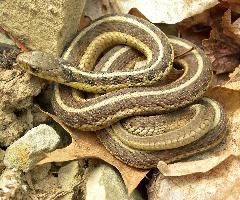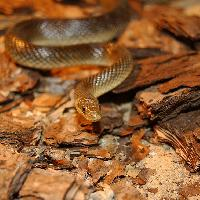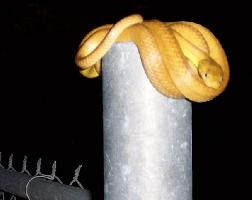
Données biologiques
| Durée de vie | de 6 à 10 ans |
|---|
Description de l'animal
The Common Garter Snake (Thamnophis sirtalis) is a fascinating and widely recognized species of snake, known for its adaptability and presence across a vast range of habitats. This species, belonging to the genus Thamnophis, is notable for its distinctive physical appearance and non-venomous nature, making it a frequent subject of curiosity and study.Physical Characteristics:
The Common Garter Snake typically exhibits a pattern of stripes running the length of its body. These stripes can vary in color, from yellow to green, and are set against a background that may range from black, brown, to olive. The snake's belly is lighter, often a pale yellow or cream. An adult Common Garter Snake can range in size from 18 to 54 inches, with females generally being larger than males. Their eyes are relatively large and possess a round pupil, which adds to their keen sense of sight.
Habitat and Distribution:
One of the most remarkable aspects of the Common Garter Snake is its versatility in habitat preference. These snakes can be found in environments ranging from meadows, woodlands, and grasslands, to the edges of water bodies like streams, ponds, and lakes. Their distribution spans across North America, from Canada down through the United States to parts of Mexico, showcasing their adaptability to different climates and ecosystems.
Diet and Hunting:
The diet of the Common Garter Snake is as varied as its habitat. These snakes are opportunistic feeders and their diet includes earthworms, amphibians, leeches, slugs, and sometimes small fish and rodents. They employ a hunting technique that relies on their keen sense of smell to locate prey, which they then capture and swallow whole. Despite being non-venomous, they have saliva that can subdue smaller prey items.
Reproduction:
Common Garter Snakes are ovoviviparous, meaning they give birth to live young rather than laying eggs. Mating occurs in the spring, shortly after the snakes emerge from hibernation. A single female can give birth to anywhere from 10 to 40 young, depending on her size and health. The newborn snakes are independent from birth, ready to hunt and fend for themselves.
Behavior:
These snakes are diurnal, most active during the daytime, especially in the morning and late afternoon. They are known for their swift reflexes and ability to escape predators. When threatened, a Common Garter Snake might release a foul-smelling musk from glands near its tail to deter predators. During colder months, they hibernate in communal dens, sometimes in large numbers.
Conservation Status:
Currently, the Common Garter Snake is considered to be of Least Concern by conservation authorities. This status is due to the snake's wide distribution and general abundance. However, like many species, they face threats from habitat destruction, pollution, and road mortality.
In conclusion, the Common Garter Snake is a resilient and adaptable species, with a wide range of physical and behavioral adaptations that have enabled it to thrive across North America. Its presence in diverse habitats and its role in controlling pest populations make it an important part of many ecosystems. Despite its common status, the garter snake continues to fascinate and inspire curiosity, serving as a reminder of the intricate balance within the natural world.
Animaux similaires
Nouvelles photos d'animaux
Top 10 des animaux
- Dolphin gull (Leucophaeus scoresbii)
- Diana monkey (Cercopithecus diana)
- Moustached guenon (Cercopithecus cephus)
- Galápagos tortoise (Geochelone nigra complex)
- Russian tortoise (Testudo horsfieldii)
- Stone loach (Barbatula barbatula)
- Japanese macaque (Macaca fuscata)
- Common flying dragon (Draco volans)
- Greek tortoise (Testudo graeca)
- Vendace (Coregonus albula)


